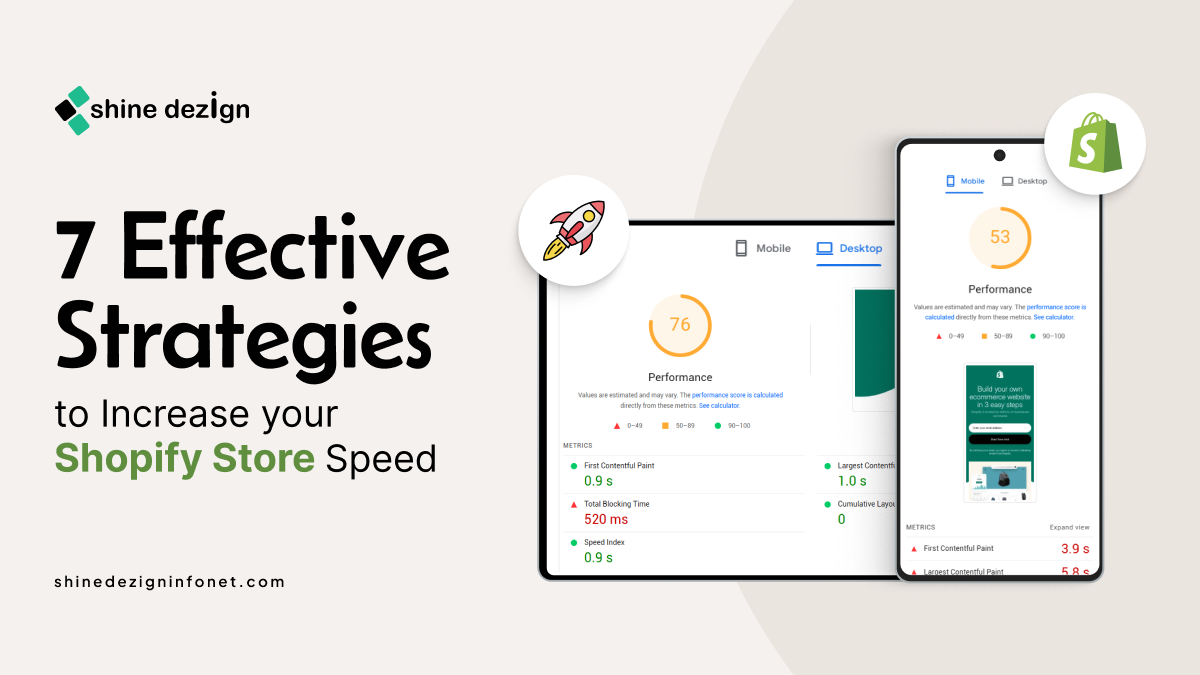Shopify speed optimization is one of the vital factors which any Shopify owners think about when they need to improve their conversion rate. Also, Shopify speed optimization is not about just improving the speed of your store, it’s also about upgrading your client experience. Therefore, in this blog, we will walk through 7 effective strategies to increase your Shopify store speed.
Why Shopify Speed Optimization Matters?
Shopify speed optimization directly impacts three vital factors that are user experience, conversion rates, and SEO. Let’s check out why Shopify speed optimization matters.
Impact on User Experience
When purchasing online, users always wanted the website they are access to load faster. If the page takes longer than 3 seconds to load, more visitors will leave the website and search for others with more speed and easy accessibility.
By optimizing Shopify Speed, you can make sure that users remain engaged, spend more time exploring products and are more likely to reach checkout page.
SEO and Google’s core web vitals

In March 2024 Google’s core update , it reinforced the value of core web vitals that measures how smoothly and quickly a web page loads and responds to user interactions.
Largest Contentful Pain (LCP)
It measures how long it takes for the largest content elements to load. For the best user experience, this may occur within 2.5 seconds.
First Input Delay (FID)
It measures interactivity, making sure the website responds quickly when a user interacts seamlessly with it.
Cumulative layout Shift (CLS)
Make sure that page is visually stable, and elements don’t unexpectedly
shift while loading.
Conversion and Revenue
Speed optimization is mostly linked to conversions. A Fast-loading site only keep users on your page longer but also boost conversion rate. Also, as per research even 1 second improvement in page load can boost 1.9% in conversion.
Let’s check out 7 effective strategies to increase your Shopify Speed Optimization
7 effective strategies to increase your Shopify Speed optimization
- Shopify App Optimization
Only optimizing Shopify website doesn’t work as most eCommerce traffic comes from Smartphone. Therefore, a slow loading app can frustrate users, leading to high bounce rate. A fast responsive app can boost user engagement, improve SEO ranking and also increase more sales.
Also, don’t forget to analyze performance and use tools like Google page speed insights to calculate the load times of your Shopify app.
Moreover, if you want to develop an appealing Shopify app for your eCommerce store, you can go with Shopify App development services that can help you to develop a good app for your eCommerce store.
- Shopify theme Optimization
Choosing a lightweight, well-coded Shopify theme is a fundamental step in optimizing your Shopify store’s speed and overall performance. Themes that are carefully designed and efficiently coded ensure faster load times by minimizing the number of unnecessary resources being loaded.
Also, you can hire Shopify experts to develop a personalized theme as per your requirement. A lightweight theme prioritizes essential functionality while avoiding unnecessary bloat, such as excessive animations, unused widgets, or redundant code that can slow down your website.
- Stop using carousel Images
Most of the shopify store utilized carousel images. Because you add so many images on the first fold on the page, also, that area usually have loading multiple images above the fold.
Moreover, they usually have large file sizes (even when optimized) and this can really slow your page down. Therefore, if you do want to have a large image at the top of your homepage, just utilize a single hero image as this will speed up your page and having a single CTA in that image will drive more traffic to that page.
- Utilize Search Engine Optimization (SEO)
SEO not only boosts organic traffic but also indirectly improves speed optimization by making your store more efficient. Also, compress images using tools like TinyPNG or Shopify’s image optimization apps to reduce load time.
Use SEO-Friendly URLs: Keep your URLs clean and relevant. Avoid unnecessary parameters that could slow down the page.
Leverage Lazy Loading: This ensures images and videos load only when users scroll to them, reducing initial page load time.
5. Don’t Ignore Content Marketing
Engaging, high-quality content drives traffic and boosts your SEO, but it must also load efficiently.
Use Lightweight Formats: Use lighter text formatting and ensure content loads dynamically without affecting page speed.
Blog Optimization: Reduce the use of heavy elements like oversized images and third-party scripts on blog pages.
Internal Linking: Create a robust internal linking strategy to guide users without overloading them with extra navigation resources.
6. Take Advantage of Unused Paid Advertising
Unused or poorly managed ad campaigns can lead to heavy scripts slowing down your store.
Remove Old Tracking Scripts: If you’ve run campaigns with platforms like Facebook or Google Ads, ensure you remove outdated pixel codes.
Reduce Third-Party App Scripts: Audit and disable apps no longer in use but still injecting scripts into your pages.
Ad Retargeting: Optimize remarketing campaigns to ensure relevant traffic while minimizing strain on page speed.
7. Minimize Redirects and Broken Links
Broken links and excessive redirects can increase page load time and frustrate users.
Conduct Regular Audits: Use tools like Google Search Console or Screaming Frog to identify and fix broken links.
Limit Redirect Chains: Replace long redirect chains with direct links. For example, avoid A → B → C and instead link directly to C.
Custom 404 Pages: Create a lightweight and informative 404 page to improve user experience if broken links are unavoidable.
By combining these strategies, you’ll ensure your Shopify store is not only optimized for speed but also provides a seamless user experience, leading to higher conversions and customer satisfaction.
Summing up
By combining these strategies, you will ensure your Shopify store is not only optimized for speed but also provides a seamless user experience, leading to higher conversion and customer satisfaction. You can follow the above-mentioned effective strategies that can help you to improve your store’s speed and performance effortlessly.


